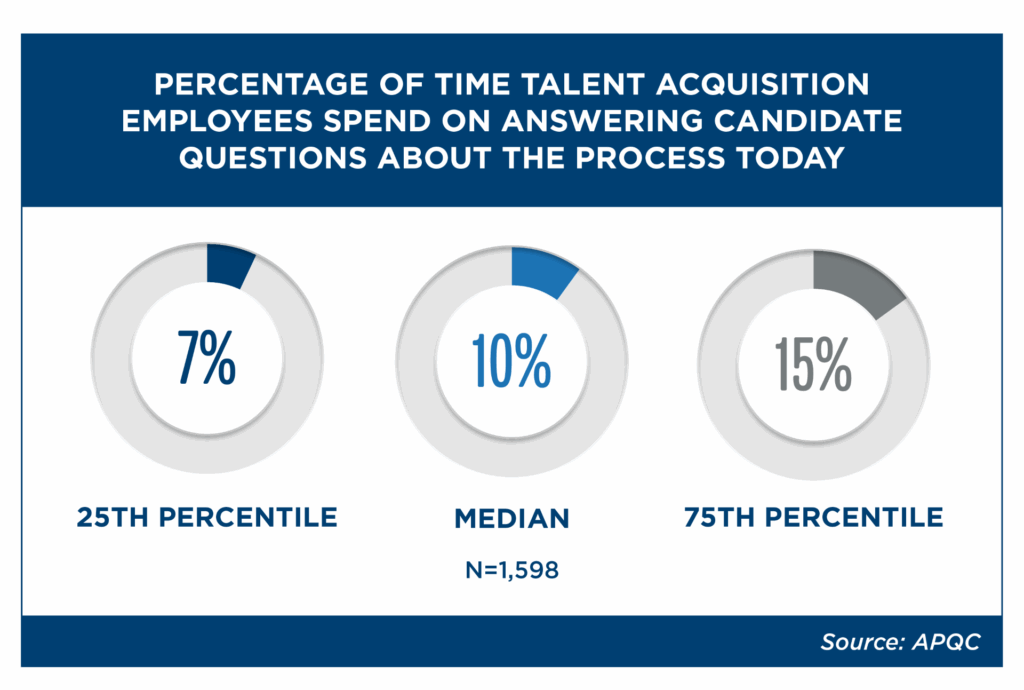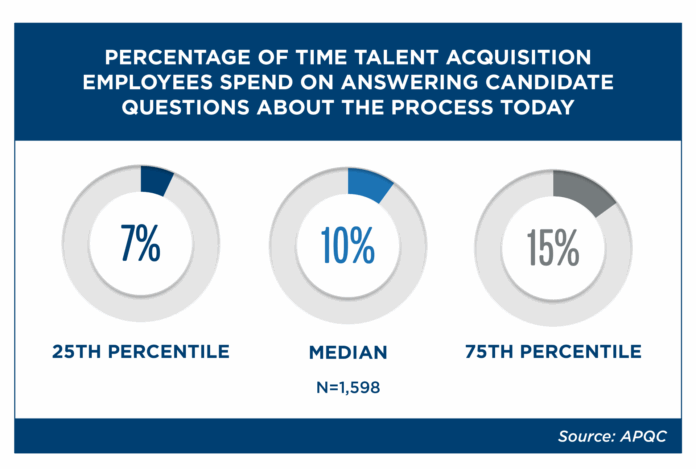Talent acquisition is at a crossroads. In an era of cost-cutting and ROI scrutiny, recruiters can no longer afford to be seen as purely transactional workers. Talent acquisition teams that can build relationships with managers and candidates, source top-tier talent and carry out other high-value work will not only be more likely to receive ongoing support but also become important strategic partners for the business. Teams that are stuck carrying out primarily transactional work are increasingly at risk of being automated or outsourced out of existence.
In this article, we’ll break down the amount of time that recruiting teams spend answering questions from candidates about the hiring process. The more time your recruiters spend on this administrative task, the less time they have for the strategic recruiting work that can help you outmaneuver your competition in the talent marketplace. After briefly discussing the benefits of technologies like AI for reducing administrative work, we also highlight seven low- and no-tech ways you can work to free up time for strategic work in recruiting.
See also: How data can support recruiting strategy for better hiring results
Tracking administrative time in recruiting
According to data compiled by the American Productivity & Quality Center, recruiters spend a median of 10% of their time answering candidate questions about the hiring process. Recruiters in the 75th percentile spend 15% or more of their time answering these questions, while those in the 25th percentile spend 7% or less of their time on the same work.

Why you should pay attention to this measure
This measure tracks the administrative time that recruiters spend on queries—not the time they spend building relationships or engaging in higher-value candidate interactions. Keeping your percentage for this measure as low as possible will leave more time for recruiters to spend on strategic tasks like sourcing, screening and relationship building with candidates and hiring managers. Helping your organization stay competitive in the talent marketplace through activities like these is always going to be a better use of your recruiters’ time than having them answer the same basic questions from candidates over and over.
There are at least three other reasons why you should track this measure:
- Scrutiny on HR costs: This and other time allocation measures can help you identify where administrative work is happening and where you can cut costs without sacrificing talent acquisition outcomes.
- Many talent acquisition functions are or will be embarking on initiatives to implement automation and AI and to streamline talent acquisition processes. This measure can be used to set a baseline before launch, assess progress along the way and demonstrate impact to make the business case for additional funds or initiatives.
- Many talent acquisition teams are striving toward more data-driven decision-making in order to provide stronger support for the business. Keeping administrative time low gives recruiters the capacity to develop and apply data and analytics to make better decisions.
Benchmarking guidance
When selecting benchmarking peers for this measure, look for organizations with similar hiring models. If you operate a chain of clothing stores and primarily carry out high-volume, low-tenure, low-skill hiring, you will want to benchmark your recruiters’ time against similar retailers or other industries that might share this dynamic.
It’s important to interpret your performance on this measure in the context of how recruiters spend their time overall. For example, we also found that recruiters spend a median of 10% of their time scheduling and following up with candidates and 15% of their time posting jobs or carrying out external marketing. It’s important to develop an accurate sense of how much time recruiters spend on all of these tasks (which, while necessary, may not yield a high return in terms of recruiter cost or time) relative to strategic, high-value tasks that deliver a strong return on investment.
You should also consider this measure in the context of other recruiting measures like time to fill, cost-per-hire, candidate satisfaction and new hire retention. If administrative time is growing, you should expect to see declining performance on these measures.
Reducing administrative work in recruiting
Technologies like automation, generative AI and agentic AI already offer promising ways to reduce administrative work in recruiting. For example, many organizations are now using AI-powered chatbots to answer candidates’ questions and quicken the pace of communication. Other tools like automated outreach platforms are also enabling recruiters to scale the process of contacting and engaging with candidates to discuss open positions.
It’s critical to handle automation and AI carefully to ensure that the candidate experience is not negatively impacted, especially in areas where you plan to replace the “human touch” (i.e., the unique relational capabilities of humans) with automation or AI. Poorly implemented technology can easily lead to candidate dissatisfaction, additional questions or bias in screening, negating efficiency gains.
7 low- and no-tech ways to reduce administrative work in recruiting
Tools powered by AI and automation have been game-changing for many talent acquisition teams. However, we’ve found that organizations can often make significant gains in process performance even without having to implement additional technology. The seven low- and no-tech strategies below provide a great place to start as you work to reduce the time your recruiters spend answering questions from candidates.
1. Simplify and streamline the hiring process as much as you can.
If you have a process management team or function in your organization, they can help a lot in this regard. Even if you don’t, you can still hold a workshop to lay out the entire process step by step, ask whether each step is necessary, clarify hand-offs and look for other opportunities to simplify the process.
2. Redesign or improve the process with the candidate perspective in mind.
Use design thinking and candidate personas to keep the focus on candidates, the journey they take through the process and where they are most likely to feel stuck or have questions.
3. Lean into transparency.
Provide upfront overviews and clear timelines at each stage so candidates have clarity about what the next steps look like.
4. Revamp candidate-facing messaging.
Enhance career sites with FAQs, process tours and proactive communications about the hiring process.
5. Reimagine your work models.
Leverage a shared services model (including tiered staffing) for the administrative aspects of recruiting. Ideally, your senior recruiters should be doing strategic work like relationship building, while newer recruiters answer tactical candidate questions or carry out administrative tasks.
6. Identify opportunities to shift tasks.
If you can’t implement shared services, you can still use case management and ticketing to triage and prioritize administrative tasks and questions so they’re not being handled by senior recruiters.
7. Outsource administrative tasks.
This approach does require a level of expertise and ongoing management to ensure that costs and service levels remain on track.
Key takeaways
Recruiters need to get administrative work off their plates to enhance their strategic impact. Tracking the amount of time they currently spend answering questions about the hiring process and on other administrative tasks is a good first step for setting a baseline and finding opportunities for improvement.
Time allocation measures aren’t just for recruiters, either. You can also use them in areas like learning and development to analyze and optimize how HR staff spends their time on administrative versus strategic work.
Teams that can carry out more strategic work (while still ensuring a positive candidate experience) will be more likely to have ongoing support from the business, even amid fluctuating hiring cycles. You don’t necessarily need to spend big to get these results. Often, simple improvements to the process and the information you provide about it can take you a long way.



